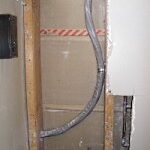When you have a large area to repair, using the stud to stud drywall repair method often makes the most sense. Drywall is an inexpensive material, and it can often be cheaper to just take out an entire section of drywall than to repair a large hole with the furring method. You don’t have to have any wood pieces available that normally would be used for furring. And you can span areas where things such as plumbing or other items in the wall rule out furring due to lack of space.
How to Repair a Large Hole in Drywall: Stud to Stud Method

- Remove damaged drywall. Locate the studs on both sides of the large drywall hole. Use a straight edge and pencil to draw a square or rectangle (vertically slightly larger than the damaged piece). A carpenter’s level, 3′-4′, works great for this and it can be a straight edge for cutting. Cut damaged piece out with a drywall saw. Remember, you’ll be attaching the new piece of drywall from the middle of one stud to the middle of the other stud so measure accordingly. If applicable, use an electric drill fitted with a drywall screw head to remove old drywall screws. If necessary, employ the use of a hammer and flat wrecking bar to help loosen the drywall piece, and remove.
Tip: Studs are usually placed every 16″ along a wall. Stud Finders are relatively cheap, and will help you identify the location of wall studs with ease. - Cut new drywall. Measure the ‘new’ hole and transfer these measurements to new piece of drywall. Reduce the measurements a 1/4″ for a better fit, not too tight but also not too loose. Pre-fit the new piece and shave the edge(s) with a drywall rasp for a good fit.
 Install new drywall. Fit drywall in place over the large drywall hole, and use drywall screws to secure it to the studs.
Install new drywall. Fit drywall in place over the large drywall hole, and use drywall screws to secure it to the studs.
Tip: Attach drywall screws every 6″-12″ along both studs. The larger the patch the more spacing between the screws. Don’t exceed 16″ spacing on the wall.- Finishing drywall. Pre-fill large gaps and seams with a thin layer of joint compound. Then, measure and cut fiber mesh tape for the edges. Apply the fiber mesh tape and cover with a thin coat of joint compound. Use an 8″ drywall knife for the first coat. Let dry, check for high/low spots, and apply a final coat of compound. Use a 12″ finishing knife to apply your final coat. Even out high spots, and feather edges. Your final application will enlarge the patch area, and that’s okay. Allow to dry completely then gently apply a sanding sponge until edges are seamless. Now you’re ready to prime and paint or finish with a drywall texture.
Tip: Use thin coats of compound to cover the large drywall hole and feather edges carefully for best results.

